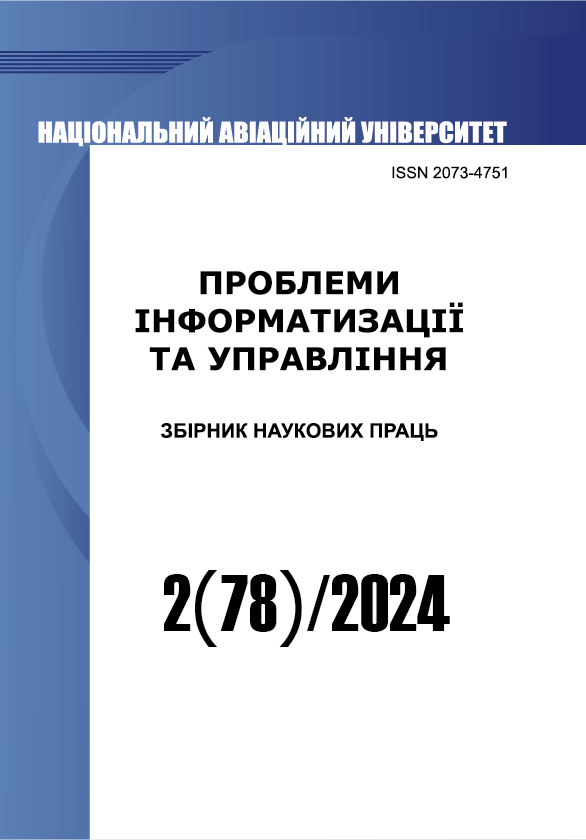Використання алгоритму трекінгу об’єкту по відеозображенню для реалізації автономної функції слідування за ціллю для БПЛА
DOI:
https://doi.org/10.18372/2073-4751.78.18956Ключові слова:
БпЛА, OpenCV, розпізнавання образів, розпізнавання зображень, трекер, автономне керування, одноплатний комп’ютерАнотація
У статті розглянуто сфери застосування БпЛА. Описана проблематика керування БпЛА оператором через пульт управління. В роботі запропоновано підхід для реалізації автономної функції слідування за заданим об’єктом. Розроблено програмну частину, що складається з модулю обробки відеопотоку, трекінгу об'єкта та формування команд керування. В програмі додатково реалізовано механізми підвищення надійності системи, такі як обробка даних для запобігання різким рухам та алгоритм відновлення трекінгу при втраті об'єкта. Описано подальші кроки для інтеграції MAVLink бібліотеки для формування керуючих команд та збірка апаратної частини системи на базі одноплатного комп’ютера Raspberry Pi та польотного контролера Pixhawk.
Посилання
Dolintse B. I. Architecture of integrated navigation systems with enhanced coordi-nate accuracy and fault detection. Problems of Informatization and Management. 2023. Vol. 2, Iss. 74. P. 31–37. DOI: 10.18372/2073-4751.74.17878.
Zhukov I., Dolintse B., Balakin S. Enhancing Data Processing Methods to Im-prove UAV Positioning Accuracy. Interna-tional Journal of Image, Graphics and Sig-nal Processing. 2024. Vol. 16, Iss. 3. P. 100–110. DOI: 10.5815/ijigsp.2024.03.08.
Mohsan S. A. H. et al. Unmanned aerial vehicles (UAVs): practical aspects, applications, open challenges, security is-sues, and future trends. Intelligent Service Robotics. 2023. Vol. 16, Iss. 1. P. 109–137. DOI: 10.1007/s11370-022-00452-4.
Unmanned Aerial Vehicle - Glob-al Forecast. Markets and Markets. URL: https://www.marketsandmarkets.com/ResearchInsight/unmanned-aerial-vehicles-uav-market.asp (дата звернення: 25.06.2024).
Patil R. R. et al. Qualified scruti-ny for real-time object tracking framework. International Journal on Emerging Tech-nologies. 2020. Vol. 11 (3). P. 313–319.
Khan N. A. et al. Emerging use of UAV’s: secure communication protocol issues and challenges. Drones in Smart-Cities: Security and Performance. 2020. P. 37–55. DOI: 10.1016/B978-0-12-819972-5.00003-3.
Janku P. et al. Comparison of tracking algorithms implemented in OpenCV. 20th International Conference on Circuits, Systems, Communications and Computers. 2016. Vol. 76. 04031. DOI: 10.1051/matecconf/20167604031.
Hong T. et al. Real-Time Tracking Algorithm for Multi-Target UAV Based on Deep Learning. Remote Sensing. 2023. Vol. 15(1). 2. DOI: 10.3390/rs15010002.
Ortega L. D. et al. Low-Cost Computer-Vision-Based Embedded Systems for UAVs. Robotics. 2023. Vol. 12 (6). 145. DOI: 10.3390/robotics12060145.
Khan N. A. et al. A secure com-munication protocol for unmanned aerial vehicles. Computers, Materials and Contin-ua. 2021. Vol. 70(1), P. 601–618. DOI: 10.32604/cmc.2022.019419.
##submission.downloads##
Опубліковано
Номер
Розділ
Ліцензія
Автори, які публікуються у цьому журналі, погоджуються з наступними умовами:- Автори залишають за собою право на авторство своєї роботи та передають журналу право першої публікації цієї роботи на умовах ліцензії Creative Commons Attribution License, котра дозволяє іншим особам вільно розповсюджувати опубліковану роботу з обов'язковим посиланням на авторів оригінальної роботи та першу публікацію роботи у цьому журналі.
- Автори мають право укладати самостійні додаткові угоди щодо неексклюзивного розповсюдження роботи у тому вигляді, в якому вона була опублікована цим журналом (наприклад, розміщувати роботу в електронному сховищі установи або публікувати у складі монографії), за умови збереження посилання на першу публікацію роботи у цьому журналі.
- Політика журналу дозволяє і заохочує розміщення авторами в мережі Інтернет (наприклад, у сховищах установ або на особистих веб-сайтах) рукопису роботи, як до подання цього рукопису до редакції, так і під час його редакційного опрацювання, оскільки це сприяє виникненню продуктивної наукової дискусії та позитивно позначається на оперативності та динаміці цитування опублікованої роботи (див. The Effect of Open Access).


